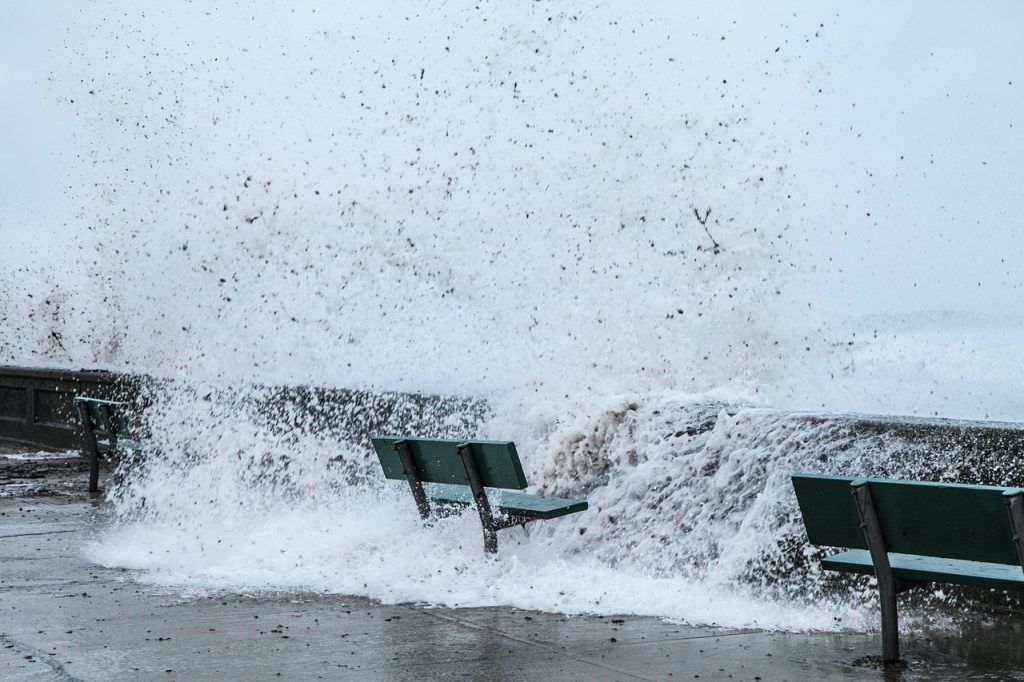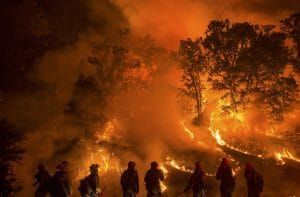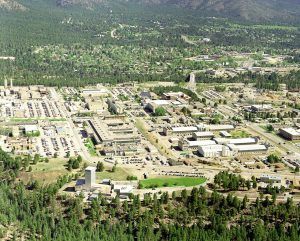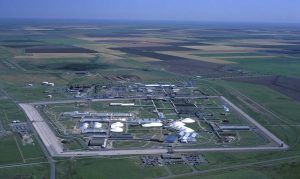Is the US nuclear community prepared for the extreme weather climate change is bringing?
By Susan D’Agostino | April 20, 2021
 Storm surge. Credit: Wikedgood. Pixabay license.
Storm surge. Credit: Wikedgood. Pixabay license.
In May 2000, a planned burn to remove dead, dried underbrush on New Mexico’s drought-stricken Cerro Grande peak in the Bandelier National Monument grew out of control. As the sky darkened with smoke, a wall of flames fueled by high winds burned through tens of thousands of acres of land where people, elk, and bald eagles made their homes. The monstrous blaze escaped the monument’s containment line and headed to the forested birthplace of the atomic bomb—Los Alamos National Laboratory. There, it raced over soil, rocks, and trees contaminated from decades-old nuclear weapons testing, releasing radioactive particles into the air and setting 47 buildings ablaze. As the devastation unfolded, the wildfire inched close to, but stopped short of, a facility containing tritium, a radioactive form of hydrogen.
“When you’re talking nuclear, it’s a magnitude of far greater risk of harm if something goes wrong,” said Alice Hill, a senior fellow for energy and the environment at the Council on Foreign Relations.

The US nuclear arsenal—which contains approximately 40 percent of the world’s nuclear warheads—has been built over decades, producing about 90 million gallons of radioactive waste. The United States also had 56 operational nuclear power plants at the end of October 2020 that together have produced over 80 metric tons of spent nuclear fuel. That waste is stored either in steel-lined concrete pools of water or in dry storage casks made of steel and concrete. Meanwhile, climate change is contributing to the intensity of drought, heat waves, heavy rain, flooding, hurricanes, and winter storms—all of which wreak havoc on infrastructure and the environment.
The US response to potential climate impacts on the country’s various nuclear activities has, in the eyes of many experts, fallen far short of what it needs to be.
“All of these [nuclear] structures were built on the presumption of a stable planet. And our climate is changing very rapidly and presenting new extremes,” Hill said. “There’s harm that stems from that.”
Drought and spent nuclear waste. When forests are drier for long periods of time, they act as kindling for wildfires. Extreme drought exacerbated by climate change is a key driver of wildfires in the Western United States, which are increasing both in frequency and in size. For nuclear infrastructure in the heart of wildfire territory, this trend spells trouble.

Consider, for example, a recent Energy Department audit of Los Alamos National Laboratory, which today employs more than 13,000 people. Energy Department auditors reported in February that measures designed to reduce the possibility that a wildfire would reach radioactive contamination—tree thinning and maintenance of access roads for firefighters and equipment, for example—had not been fully implemented. They also found no evidence that wildfire prevention planning and preparation had been completed, as required by the Federal Wildland Fire Management Policy. These failures should sound alarm bells, given that smoke from wildfire on contaminated soil may carry radioactive and toxic chemical waste off site.
“I would have thought that the Cerro Grande Fire might have caused them to get some religion,” said Robert Alvarez, a senior scholar at the Institute for Policy Studies.
More recently, the Woolsey Fire burned through the site of the former Santa Susana Field Laboratory, on the outskirts of Los Angeles. Though not in use today, the Santa Susana site remains contaminated from several earlier nuclear reactor accidents. Though the US government denied that smoke carried radioactive or chemical contaminants off site during the 2018 fire, nuclear experts have expressed serious doubts about that claim.
“The fallout from a very bad disaster will not honor our jurisdictional boundaries. A nuclear disaster can spread far. The stakes are very high,” Hill said.
Floods and nuclear power plants. The likelihood of a hurricane developing into a Category 3 or larger storm has increased by about eight percent per decade since 1979, according to a 2020 study. What were once called once-a-century rainstorms are now expected every one to 30 years.
By the end of this century, sea levels could rise by as much as eight feet above 2000 levels if humans continue on a high-emission trajectory, according to a recent post on the National Oceanic and Amospheric Administration’s climate.gov website.
“There can be failures of imagination. Certainly, the Japanese never imagined an earthquake followed by a tsunami,” Hill said, referring to the Fukushima Daiichi Nuclear Power Station disaster in 2011.
Nuclear power plants are often located near bodies of water used for cooling purposes. In the United States, three plants in particular—Humboldt Bay in California and Turkey Point and Crystal River in Florida—would be surrounded by water in the event of a six-foot rise in sea levels. Even if flooding does not cause a disaster, it could damage facilities or prevent workers from gaining access to a plant during a time of increased demand.
“Much of the [nuclear power plant] fleet was built in the ‘70s, when climate change was not a consideration. There really haven’t been systematic adjustments to make sure that plants can operate in new extremes or that they’re protected against them,” Hill said.
Beyond causing a rise in sea level, climate change is a factor in an increase in extreme rainstorms that cause severe flooding.

“I thought it was stunning that a site like Pantex would have flash floods that would inundate a magazine full of plutonium canisters,” Alvarez said, talking about the “once-in-2,000-year” floods that hit Amarillo, Texas in 2010 and 2017 and inundated a plutonium storage area at the Pantex Plant, where US nuclear weapons are assembled and taken apart.
“That’s a very dangerous situation to have a water-and-plutonium mix,” said Alvarez, noting that sealed canisters could corrode in the presence of water.
Needed: a better response to the interplay of climate and nuclear threats. In the face of an unprecedented rise in the strength and frequency of storms, droughts, wildfire, and flooding, those charged with oversight of US nuclear infrastructure and waste should be energetically guarding against known vulnerabilities. But the US response has largely been one of inaction.
The average US commercial nuclear reactor was 39 years old as of December 2020; the Nuclear Regulatory Commission grants initial commercial power reactor licenses for up to 40 years. The licenses can and often are renewed, but operation beyond 40 years is known as a “period of extended operation.” The Office of Nuclear Energy claims that its power plants are “proving that age is really just a number.” However, many nuclear experts disagree, especially when advanced age is considered together with industry cost-cutting measures, reduced safety oversight, and the new stresses brought on by climate change.
“In the drive for clean energy, people want to extend all of these [nuclear power plant] licenses, but they’re not thinking through, ‘Are these facilities really up to this?’” Hill said.
Together, we make the world safer.
The Bulletin elevates expert voices above the noise. But as an independent nonprofit organization, our operations depend on the support of readers like you. Help us continue to deliver quality journalism that holds leaders accountable. Your support of our work at any level is important. In return, we promise our coverage will be understandable, influential, vigilant, solution-oriented, and fair-minded. Together we can make a difference.
Keywords: United States, climate change, nuclear power plant, nuclear risk, nuclear waste
Topics: Analysis, Climate Change, Nuclear Energy, Nuclear Risk, Nuclear Weapons
















Nuclear power engineering and radioactive waste storage is built upon the assumption of a continuing stable industrial infrastructure. It has been driven by the hubris of a ‘nuclear priesthood.’ Even today the large pool of nuclear power advocates assume that we have 20-30 years to replace most current fossil fuel use with energy produced by the existing, or new technology, nuclear power sources. Almost all of them are clueless regarding statements such as the following. UN chief: World has less than 2 years to avoid ‘runaway climate change’ https://thehill.com/policy/energy-environment/406291-un-chief-the-world-has-less-than-2-years-to-avoid-runaway-climate UN Chief warns countries that the ‘point of no return’ on… Read more »